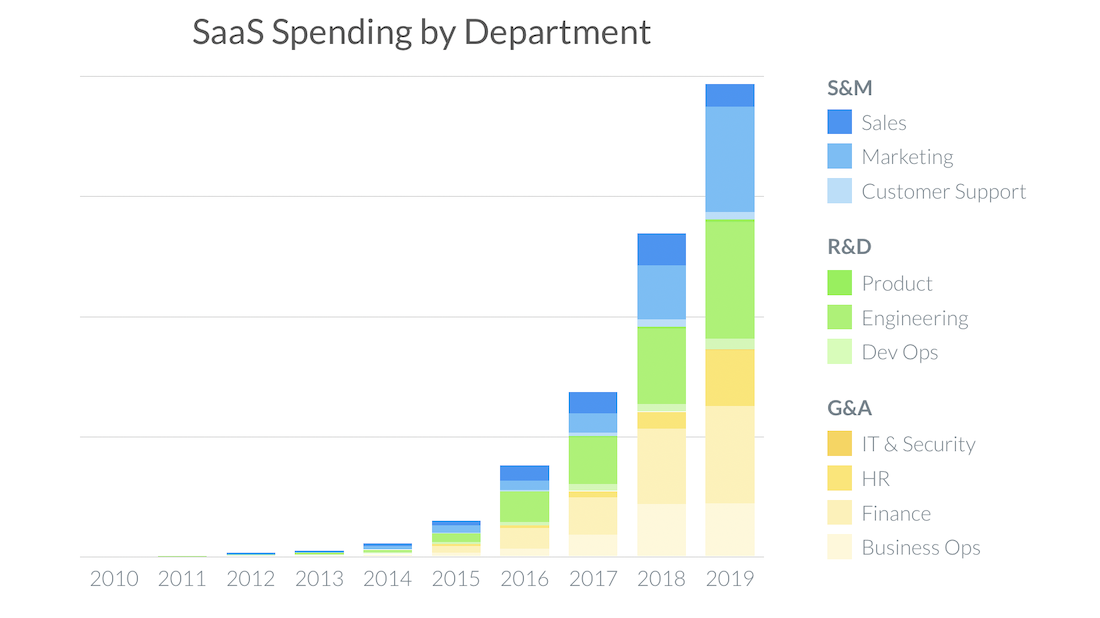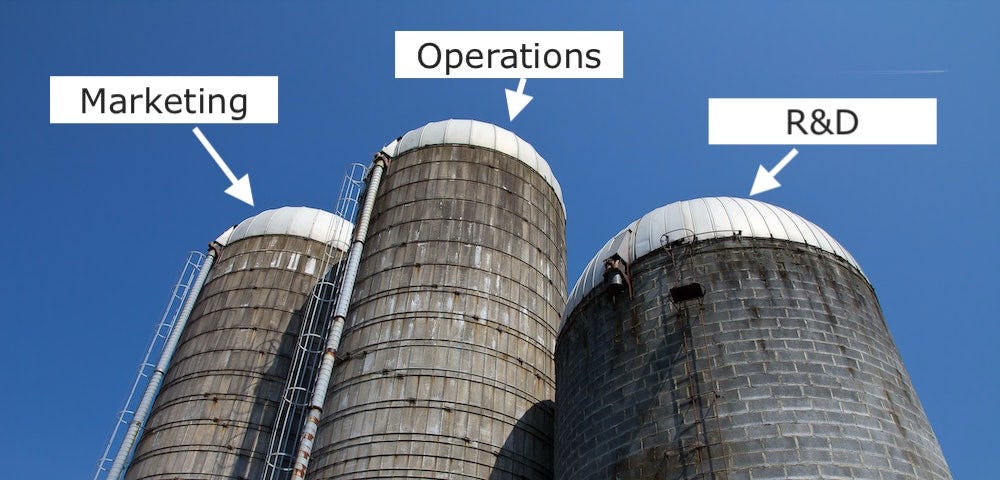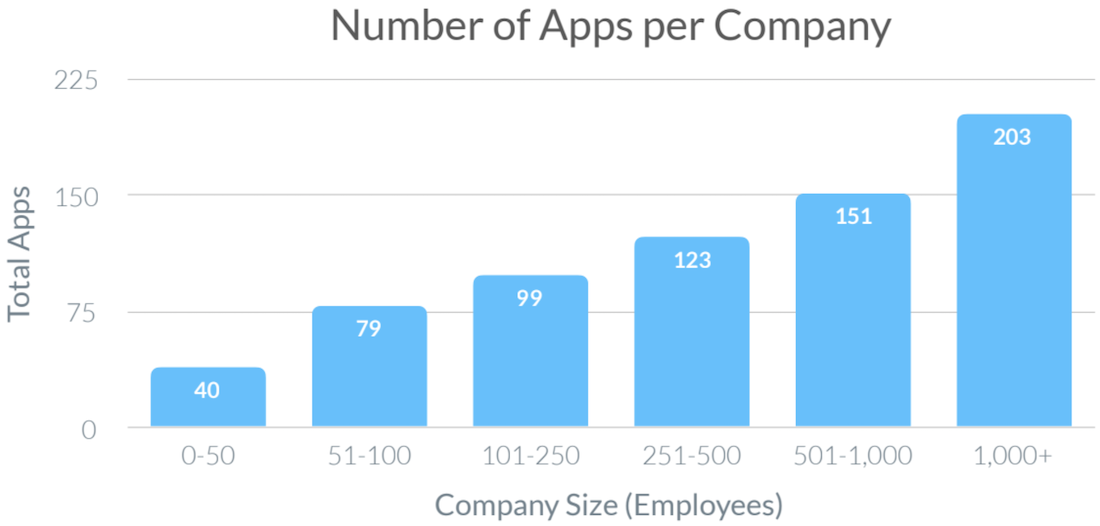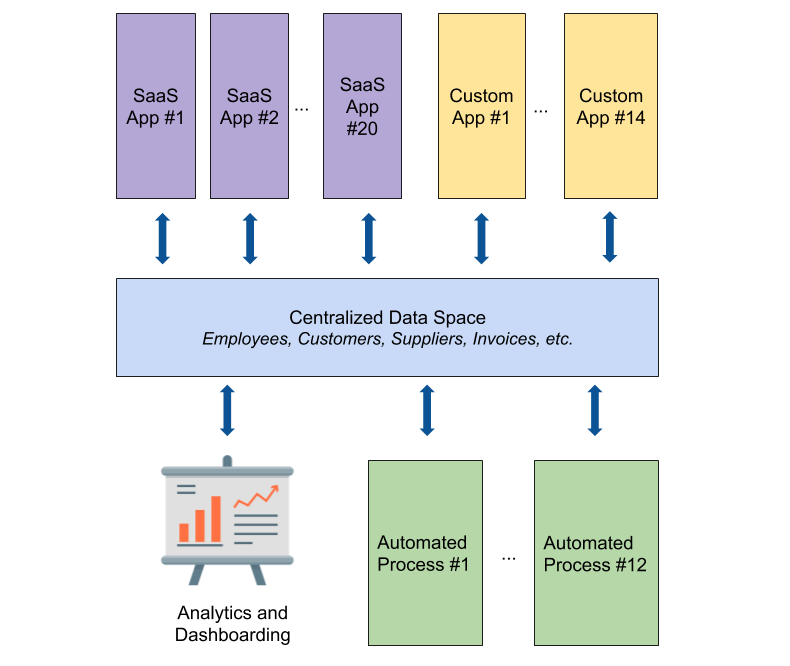Since the beginning of the digital transformation in the 1960s, enterprise software has played a key role in increasing companies productivity. They have moved from custom development, to ERP, to the current best-of-breed approach. Automation and AI are around the corner to drive the next revolution. If the different shifts in technologies that happened in the past are any clues to look forward to, chances are the future of enterprise software will look very different than today.
1. The ERP age
Before the 1980s, most of enterprise software programs were custom built. The 1980s brought software standardization with applications developed to manage inventory and manufacturing processes in the industries. Applications spread to all the business needs including finance and human resources. In 1990, the advisory firm Gartner coined the term ERP (for "Enterprise Resource Planning") to refer to this category of business management software programs.
The following decade, the 1990s, was the golden age for ERPs with rapid growth in adoption across medium and large companies in a market dominated by firms like SAP, Oracle, and HP with on-premise solutions.
1.1. Where ERPs shine
Data centralisation
The major innovation introduced with ERP is a central and real-time view of the company data. Inventory, Finance, HR and other applications share a unified data storage. This data consolidation enables cross departments analytics and simplifies company planning.
Extensible
Moreover, ERPs are extensible. All the applications living in the ERP share a common underlying architecture and have the same interface components. All the ERP market leaders expose their platform to external developers. This creates opportunities for third parties applications, and internal processes that are too specific to the company can be built as applications on top of the platform.
1.2. ERP limitations
Complexity
This globally consistent view of company financials and inventory come at the expense of complexity. A triple complexity! Complexity to implement, to use, and to extend.
ERP systems come in a one-size-fits-all monolith strategy. To be implemented in a company, the company must comply with how the ERP works. ERP applications are not flexible enough to map custom processes the company might be using. When you add that the implementation must cover several departments, therefore several applications, to be valuable, you end up with scary stories. In 2017, the German grocery chain Lidl, after 6 years and $500 million spent in SAP implementation, decided to roll back the entire inventory system to their previous custom made platform. More recently in Australia, a SAP implementation in Australia cost 33,5 Millions $ (AUD) more than planned with mixed results.
It is not surprising that small companies, looking for fast implementation and flexibility, are only a few to use ERPs.
When implemented, ERPs are hard to use. Because all applications are built with the same components, they all share the same User Interface patterns. The interface is more a representation of the underlying data than a targeted interface for a defined application.
To finish on the complexity issue, unlike the promise, extending an ERP is not easy. First of all, they are monoliths. Meaning all the applications and data live in a single system. Developing over it can impact the stability of other applications. Motivation to develop an application on the ERP must be validated by the company. A single team wouldn't take the responsibility to extend the company ERP without asking permission. In addition, if an existing application doesn't suit the organization, customizing the code prevents the organization from automatically updating the application when a new version is available. Resulting in maintenance time and instability.
Closed world
ERPs live in a closed world. They are only designed to interact with the company employees. Suppliers, partners, and customers, although modeled in the ERP database, do not interact directly with it.
The isolation is also true for the applications. Only applications designed for the ERP will play nicely with the data and the processes integrated with it. Interconnecting an ERP with external HR or Finance software is complex and this is not the way ERP vendors want you to use their product.
As a result, you need an SAP software developer to build an application on the SAP platform. Some technologies are proprietary and diverged from other programming languages and practices used elsewhere. As a result, salaries for ERP developers are higher than average.
Lock-in
Long implementation, centralized data, and closed world inevitably introduce vendor lock-in. The average ERP life cycle in a company is 15 years (time between a first implementation and a new implementation). As a result, the market is concentrated in the hands of a few big players. And it is not to displease them.
2. The best of breed revolution
Starting in the 2000s, enterprises moved from vertically integrated organizations toward agile and domain specialized entities. This move was accompanied by companies opening to the outside world, especially to interact with customers. The one-size-fits-all ERP systems started to lose momentum in favor of specialized cloud-native applications. From a single system, the organizations were now choosing to have different software programs, often from different vendors, to meet their ever-growing needs. Over the past few years, an increasing number of companies have switched to this approach, called “best of breed”.
2.1. The benefits of best of breed
Cloud Native
The rising of best of breed philosophy is concomitant with the rise of SaaS (Software as A Service) that live in the cloud. This new wave of enterprise software embraced the possibilities created by the cloud and offered a totally different experience.
Compared to on-premise hosting, cloud-native applications are fast to implement. The setup no longer involves buying servers and sizing the infrastructure but is reduced to configuration and interconnection with the company's other systems, shortening the time to market. Software update responsibility returns to the software vendor, saving the company maintenance cost.
It also changes the business model of enterprise software vendors. They switched from set up fees + product licenses to on-demand pricing. How many employees do you have? How many customers? The goal is to capture value as the company grows.
With this fast implementation and linear pricing, a myriad of new software editors was created to target all company size. From small companies to multinationals.
Flexibility
Single-purpose applications bring flexibility to the company. Because it is hosted by the vendor, decision to use an application is slowly pushed back to the team responsibility. With companies embracing agile organization, teams are empowered to test and decide on their own the tools they want to use. Once implemented, if the results are insufficient, the team can switch to another vendor while keeping the other applications it might use. This “test fast, change fast” is another principle of agility and it is meant to accelerate innovation.
Most of the best-of-breed applications expose API to connect them with other applications. The enterprise processes are then scattered across multiple applications.
Easy to use
Because applications address specific needs, the user interface can be adapted to the intended user who is using the applications. Applications meant for salespeople can have a different user interface than the ones for human resources people. With all the existing devices (smartphones, tablets, laptops, smartwatches, etc.), software vendors can offer personalized user experiences.
Open to the external world
Finally, best-of-breed applications unveil a first step toward opening the enterprise software to the external world. Where ERPs focuses on company members, applications now interact directly with external parties: customers, suppliers, partners, etc.
This opening is still limited but the trend is accelerating.
2.2. Best of breed downsides
The best of breed approach comes with its own challenges, especially the consequences of having a system made of multiple programs, data storages, and vendors.
Siloed Data
Ironically, while ERPs main advantage is a central data storage, the biggest issue with best-of-breed patterns is data silos. Every software is independent and has a dedicated database. On a company scale, data silos reflect the different business units and teams.
This has consequences. First, generic data types like customer information might be stored in a CRM only accessible for a part of the company, preventing people from having access to important information. And even if the CRM is connected to other programs to expose customer information, it can lead to data duplication and inconsistencies. This is referred to as the "source of truth" problem.
Finally, when the data is kept in several places, the company doesn't have a global view of its activity. Running analytics to find a correlation between data is not possible. Aligning vision, automation, analytics and planning get complicated without a global view of the data.
Integration Complexity
In the best-of-breed world, software vendors focus on their application. Complexity is moved to integrating the applications together. How to connect data between applications? How to keep it secure? How to synchronize common objects (like customers) across them? These questions are left to the companies to answer.
In a 2019 survey conducted by Mulesoft, a provider of integration solutions, IT leaders reported that only 29% of their applications are currently integrated together.
There are diverse reasons for this lack of integration. Data models are different between applications. Customer attributes in a CRM can be different than the ones needed in a financial application. They are different and the data models can change. The frequency of deployments (and changes) is increasing with the use of agile methodologies adopted by more and more software vendors. Furthermore, some software vendors don't want to expose their data. In the data gold rush, it is better to receive data from other applications than expose its own data for others to create value with it.
Companies are far from reaching a global view of their operations with this scattered data.
Hard to build on top of an applications mesh
From an ERP market with few big players, the best-of-breed approach has enabled new vendors to join the enterprise software dance. This leads to vendors offering specialized applications to many niche markets.** Yet, often, an organization's digital system can't be only made of vendor applications. Custom development is needed to answer specific needs.**
Best of breed makes it difficult to build a custom application on top of this distributed system. Integration with vendor applications is not always possible. Some applications offer packaged integration with other market leaders but don't open their API to custom development. Hosting, testing, and maintenance lead to high cost for internal application development.
Duplication of costs
To conclude on the downsides, the costs of all the applications can add up to become quite expensive. Keeping track of all the applications used in the company is not easy, some vendor licenses keep being paid while not used. Hundred, or thousands of business applications can drain down the profitability of the organization.
3. The future of enterprise software
Marc Andreessen famously said in 2011 that "software is eating the world". Companies that embrace software both in their operations and as a driver of growth will continue to lead the digital transformation. Predicting the evolution of enterprise software is not easy, but we can look at the current trends to predict what will happen in the market.
The following paragraphs are what we, at Datablist, believe will shape the future of enterprise software. We can see four strong tendencies:
- Agility and the power of autonomous teams.
- AI, automation and analytics in data-driven organizations.
- Leveraging collaboration with the external world
- Security concerns in a competitive and hostile world
3.1. Agility and the power of autonomous teams
Agility can be defined as an employee's capacity to analyze information in the environment and respond to that information quickly and autonomously. It has been proven that decentralization is key to maintaining innovation and adaptation in an ever-changing world.
We believe the enterprise software landscape will continue to be trusted by best-of-breed vendors instead of all-in-one ERP solutions.
- SaaS solution living in the cloud and pay as you go. Flexibility and fast implementation is where SaaS software shine. Cloud-native applications bring automatic updates, few maintenance costs, and predictable pricing. Data ownership and security with the cloud are growing concerns for companies but the SaaS vendors are adapting to those needs and we see no reason the cloud would lose it current momentum.
- Customer-centric experience. Agility means the buyers are now the users. Developers can choose the tools they want to use, salespeople can decide what CRM they will work with. This need for flexibility can only be achieved with the best-of-breed approach. They choose their products based on online reviews and network feedback. They are informed buyers and want to choose and not be sold to. User experience and design will be more and more important in enterprise software.
3.2. AI, automation, and analytics in data-driven organizations
Productivity increase in an organization comes from both employee productivity gain and automation of organization tasks. Automation relies on data. The businesses that will benefit from automation are the ones that will build a consolidated data view on top of their mesh of best-of-breed applications.
A centralized data space
Connecting best-of-breed applications together is not enough. First, you are limited by the connectors the applications provide. Applications have connectors to market leaders. But what about small vendors? Worse, what about your internal custom applications? Second, it is not in the best-of-breed vendor's DNA to make sense of the other application's data.
Your CRM doesn’t care about your employees data
A centralized data space gives the organization a consolidated view over the data, whether it is users generated data or organization-generated data.
We believe enterprise data warehouses will gain popularity as a foundation for automation and internal custom applications.
Platform to build on top of the data
Despite the ever-growing number of enterprise software programs, there will still be times where custom development would make more sense. Those internal applications will sit on top of the centralized data space and use the data to deliver value to the organization.
Modern development tools are shortening the development life cycle. Serverless and container technologies are perfectly suited to embrace this trend.
Components and APIs that solve a single purpose will work as building blocks for those internal applications. OCR technologies, text analysis, company verification services are generic needs that will be provided off the shelf.
3.3. Leveraging collaboration with the external world
Innovation comes when the best idea wins regardless of whether the idea comes from. This first means organization must aggregate insights and ideas from everywhere. We have seen companies opening up to customers to listen to their feedback. This trend will accelerate. Contributions can come from employees, customers but also vendors or partners. Organizational boundaries will be porous so all the community can participate in the company mission and be involved in the decision-making process.
We already see tech companies betting on open source, sharing their working methodology, the design patterns, and overall being transparent on what they learn. It engages employees and creates purpose.
Enterprise applications will foster collaboration, with people inside the company and outside of it.
3.4. Security concerns in a competitive and hostile world
The more organizations become digital and open, the more they are vulnerable. Losing trust from customers in this flexible market is not acceptable.
Organizations will use automatic tools to constantly audit their assets and vulnerabilities. Developer's codes, vendor applications, and products will be mapped in a global view of the organization systems.
Conclusion
As companies move from a single one-size-fits-all ERP world to a galaxy of SaaS applications, new problems arise:
- Data is siloed between Sales, R&D, Operations, etc.
- Processes based on multiple data sources cannot be automated
- Companies can’t build applications over this mesh of SaaS tools
At Datablist, we believe those problems can be solved with a secure centralized data space coupled with a platform to build custom applications and automation.
If you share our vision, subscribe to our newsletter below and follow us on Twitter 🤝.







